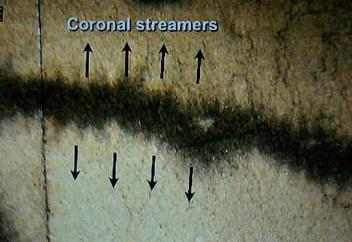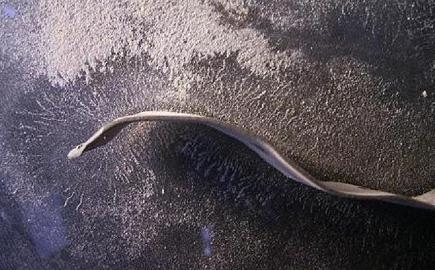All HTML pages in this directory

Photo credits: European Space Agency (HiResStereoCam)
Note the slumped section in a distant part of the mound.
With gravity at a minimum we should ask for other explanations for this feature.
In CRT experiments we have seen that electric discharge of the surface involves
undermining material with electric forces which facilitates material displacement.
There are multiple ways in which the electric force manifests itself,
of interest here are those which relate to rapid discharge of a surface
through objects on that surface.
An electric wind plays an important role of Electric Discharge Machining (EDM) as does corona emissions. The latter, will manifest itself in a variety
of ways, from barely noticeable to lethal. A single coronal streamer also manifests it own streamers. Here I think we are looking at an inverse
aspect of corona emission, here the current is not sustained in the conductor which only serves as a path for discharging the surface below. The tendrils which sweep across the surface seem to mimic corona behavior. At this low energy
the ends are rounded which differs slightly from the apparent pointed ends at higher levels as seen in the left image from this experiment by C.J. Ransom but a close up look shows rounded ends.


Image from Thunderbolts Project video "Lightning Scarred Mars"
Some details just came to my attention(8/14), presented at this link by Wal Thornhill in 2003.
The paralell paths have a counterpart at the surrounding canyon walls.
The filamentary coronal paths radiating perpendicularly from the ridge seem
to be involved in sculpting the scallops on adjacent walls of the canyon.
 _
_ 


The most important detail of these two images is toward the center of the page where loss of contact between the metal strip and the CRT caused the discharge to jump a gap to get the the strip. This might have created a
reversal, of the typical pattern, creating an inverted fan instead.
3D images can also be found for this experiment session in Pre-conference image directory 2012


Candor Chasma,, NE Leg of VM.
A detail worthy of close consideration is the presence of a central ridge feature within the two trenches shown already. On each side of the ridge
are excavations with cross-sectional sub-excavations which are in line with the scallops on either face and the central ridge grooves. This is a pattern seen in the CRT experiment where axial discharge pathways offer an opportunity to show
their corona's interaction with the dust covered surface as a current is taken
through the conductor, thus discharging the CRT surface.
Hebes canyon and the NE leg of Valles Marineris (Candor Chasma) seem to be left in the early stages of excavation, and -wrt- Candor, two details seem significant: the long
characteristic of the perimeter's in-running ridges ; and their hung-ridges, which have
perpendicular orientation to the ridge they hang from. It seems that we may be
seeing corona affect at two scales: one that comes off the central ridge and reaches to the scallops of the perimeter wall; the other which radiates from the up-scaling
tendril and climbs the remnant material between each primary tendril.
This can be seen in many of the ridge2wire image mentioned on this page and
in the lab group directory.
Electric-spark-scars crt11 Image preview